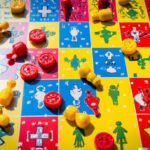Draughts, also known as checkers, is a timeless classic kids board game that has been enjoyed for centuries. This exciting and strategic game has remained popular among children and adults alike, and its appeal continues to endure through the generations. With simple rules yet complex strategies, Draughts provides hours of entertainment while also sharpening critical thinking skills in young players.
Dating back to ancient times, Draughts has a rich history that has transcended cultures and time periods. From its origins in various civilizations to its modern-day popularity, this beloved board game has captivated the minds of countless individuals throughout history. Whether played on a traditional wooden board or in a digital format, Draughts remains a favorite pastime for kids of all ages.
In this article, we will explore the fascinating history of Draughts, provide a step-by-step guide for kids to learn how to play, discuss the benefits of playing the game for young minds, and examine its potential as an educational tool. Additionally, we will delve into the evolution of Draughts from traditional to digital versions for kids and provide valuable tips and strategies for mastering the game.
Join us as we embark on a journey through the world of Draughts and discover why it will always hold a special place in the hearts of kids everywhere.
History of Draughts
The history of Draughts dates back centuries, with evidence of similar games being played as far back as 3000 BCE in Egypt. Known as one of the oldest board games in the world, Draughts has evolved over time and gained popularity across different cultures and regions. The game has been known by various names such as “checkers” in the United States and “draughts” in the United Kingdom, but its fundamental gameplay remains the same.
Ancient Origins
The origins of Draughts can be traced to ancient civilizations such as Egypt, Mesopotamia, and Greece. Archaeological findings have revealed game boards and pieces that resemble the modern-day version of Draughts, indicating its widespread popularity in ancient times. The game was often played by people from all walks of life, from nobles to commoners, making it a universal pastime for people of all ages.
Global Spread
As centuries passed, the game of Draughts spread to different parts of the world, evolving into various regional versions with distinct rules and strategies. The game became particularly popular during the 19th century when formalized rules were established, leading to organized competitions and tournaments. Its simple yet challenging gameplay made it a favorite pastime for kids and adults alike, contributing to its widespread appeal.
Modern Popularity
In today’s digital age, Draughts continues to thrive as one of the most beloved classic board games for kids. With online platforms and mobile applications offering virtual versions of Draughts, new generations are discovering and embracing this timeless game. Despite the advancements in technology and gaming trends, Draughts remains a staple in many households and educational settings, showcasing its enduring appeal across generations.
How to Play Draughts
Draughts, also known as checkers, is a classic board game that has been enjoyed by generations of kids and adults alike. The game is easy to learn, yet challenging to master, making it a favorite pastime for many. Below is a step-by-step guide for kids on how to play this timeless game.
Setting Up the Game
To start a game of draughts, you will need a standard 8×8 checkerboard and 24 draughts pieces, 12 for each player. The pieces are typically red and black, or any other contrasting colors. Each player will place their pieces on the dark squares of the three rows closest to them.
Moving the Pieces
Players take turns moving their pieces diagonally forward along the dark squares of the board. A piece can only move one square at a time, and can only do so diagonally. If an opponent’s piece is directly diagonal from your own, you can jump over it to capture it. Multiple jumps can be made in a single turn if set up by previous jumps.
Crowning Kings
When a piece reaches the opposite end of the board, it is crowned as a “king” by placing another piece on top of it. Kings have more freedom of movement as they can move and capture both forwards and backwards diagonally.
Draughts is not just an enjoyable pastime; it also offers numerous benefits for kids. From enhancing critical thinking skills to promoting strategic planning, this classic board game provides valuable lessons for young minds. So gather up some friends or family members and start playing this timeless game today.
Benefits of Playing Draughts
Draughts, also known as checkers in some parts of the world, is a timeless classic kids board game that has been enjoyed for centuries. Beyond being an enjoyable pastime, playing draughts also offers numerous benefits for kids, including the enhancement of critical thinking and problem-solving skills. Through this beloved game, children can develop important cognitive abilities while having fun.
When kids play draughts, they are required to think ahead and strategize their moves in order to outmaneuver their opponents. This constant need to anticipate the opponent’s next move and plan several steps ahead helps children sharpen their critical thinking skills. Additionally, when faced with multiple potential moves, kids must analyze the consequences of each option and make decisions accordingly, thereby honing their problem-solving abilities.
Moreover, playing draughts can also improve a child’s concentration and focus. In order to excel at the game, kids need to pay close attention to the position of each piece on the board and consider various possibilities before making a move. This heightened level of concentration can be beneficial in other areas of their academic and personal lives as well.
In fact, studies have shown that children who regularly engage in strategy-based board games like draughts tend to perform better academically compared to those who do not. The skills developed through playing this classic board game can have a positive impact on a child’s overall cognitive development. With these advantages in mind, it is clear that introducing kids to draughts can be beneficial for their intellectual growth and development.
| Benefits | Skills |
|---|---|
| Critical Thinking | Problem-Solving |
| Concentration | Cognitive Development |
Draughts in Education
Draughts, also known as checkers, is a timeless classic kids board game that has been enjoyed by children for centuries. In addition to being a fun and engaging pastime, draughts can also be a valuable learning tool for kids. This section explores the various ways in which the game of draughts can be used to benefit children’s education.
One of the primary educational benefits of playing draughts is the enhancement of critical thinking and problem-solving skills. As kids engage in strategic gameplay, they are required to think ahead, anticipate their opponent’s moves, and make calculated decisions. This not only sharpens their analytical abilities but also teaches them the importance of foresight and planning.
Furthermore, incorporating draughts into education can also improve children’s concentration and focus. The game requires players to pay close attention to the board and their opponent’s moves, thus helping them develop better attention control. Additionally, it can encourage perseverance as kids learn to work through difficult challenges and setbacks during gameplay.
Another key advantage of using draughts in education is its ability to teach children valuable social skills such as sportsmanship, cooperation, and communication. As kids interact with their peers through friendly competition, they learn how to respect rules, handle wins and losses gracefully, and effectively communicate their strategies during gameplay.
| Educational Benefits | Examples |
|---|---|
| Enhancement of critical thinking | Thinking ahead, anticipating opponent’s moves |
| Improved concentration | Paying close attention to board and opponent’s moves |
| Development of social skills | Sportsmanship, cooperation, communication |
The Evolution of Draughts
Draughts, also known as checkers, has evolved over the years from its traditional form to digital versions that kids can enjoy today. The game has stood the test of time and continued to adapt to modern technology, making it accessible and enjoyable for a new generation of players. Here are some ways in which draughts has made the transition from traditional to digital formats for kids:
- Online Platforms: With the rise of online gaming, kids can now play draughts with friends or against computer opponents on various gaming platforms and websites. This allows them to enjoy the game without needing a physical board and pieces.
- Mobile Apps: Many developers have created mobile apps that offer a digital version of draughts for kids to play on their smartphones or tablets. These apps often include interactive features, tutorials, and different levels of difficulty to cater to players of all skill levels.
- Video Game Adaptations: Draughts has also been adapted into video games for consoles, providing a more immersive and visually stimulating experience for kids who enjoy digital gaming.
The evolution of draughts from traditional to digital versions has certainly made the game more accessible and appealing to kids. With the convenience of online platforms, mobile apps, and video game adaptations, children can easily learn and enjoy this classic board game in a variety of digital formats. As technology continues to advance, it’s exciting to see how draughts will further evolve in the digital realm for future generations of young players.
Top Tips and Strategies for Kids to Master the Game of Draughts
Understand the Rules and Concepts
Before diving into a game of draughts, it is important for kids to have a clear understanding of the rules and concepts involved. This includes knowing how the pieces move, how jumps are made, and understanding the goal of the game. By familiarizing themselves with these basic principles, kids can set a solid foundation for mastering the game.
Think Ahead and Plan Moves
One key strategy in draughts is to think ahead and plan future moves. Encourage kids to anticipate their opponent’s moves and consider multiple possible outcomes before making a decision. This type of forward thinking can help them stay one step ahead in the game and increase their chances of success.
Control the Center of the Board
Controlling the center of the board is an advantageous position in draughts. Teach kids to focus on gaining control over this area as it provides more opportunities for their pieces to move and attack. By strategically positioning their pieces in the center, kids can exert greater influence over the game and create potential threats against their opponent’s pieces.
As kids continue to play draughts and implement these tips and strategies, they will not only improve their gameplay but also develop essential skills such as critical thinking, strategic planning, and problem-solving. With practice and perseverance, mastering this classic board game can be a rewarding experience for young players.
The Future of Draughts
In conclusion, it is clear that Draughts, as a timeless classic kids board game, holds a special place in the hearts of children and adults alike. Its rich history, from ancient roots to modern popularity, showcases its enduring appeal and longevity. The game provides countless benefits for children, such as enhancing critical thinking and problem-solving skills, making it an ideal choice for both entertainment and education.
As technology continues to advance, the evolution of Draughts from traditional to digital versions allows kids to enjoy the game in various formats. Whether played on a physical board or through digital platforms, the essence of Draughts remains unchanged, providing endless opportunities for kids to engage in strategic gameplay and friendly competition.
Looking ahead, the future of Draughts appears promising as its status as a favorite board game for kids shows no signs of fading. With its ability to adapt to changing times while retaining its classic appeal, Draughts will continue to captivate young players and serve as a beloved pastime for generations to come. It is safe to say that this timeless classic kids board game will always hold a special place in the world of children’s games.
Frequently Asked Questions
Which Classic Game Is Known as Draughts?
The classic game known as draughts is called Checkers in the United States and Canada. It is a popular strategy board game that has been enjoyed for centuries by people of all ages.
How Do You Play Draughts for Kids?
Playing draughts with kids can be a fun and educational experience. To start, teach them the basic rules of the game, including how the pieces move and capture opponents’ pieces. Encourage them to practice their critical thinking skills as they strategize to win.
How Do You Play Classic Draughts?
Classic draughts, or checkers, is played on an 8×8 checkerboard with 12 pieces per player. Players take turns moving their pieces diagonally forward and can capture opposing pieces by jumping over them.
The goal is to capture all of your opponent’s pieces or block them from moving. It’s a simple yet challenging game that requires strategic thinking and planning ahead.

I love playing all kinds of games – from classics like Monopoly to modern favourites like Ticket to Ride.
I created this blog as a way to share my love of board games with others, and provide information on the latest releases and news in the industry.





